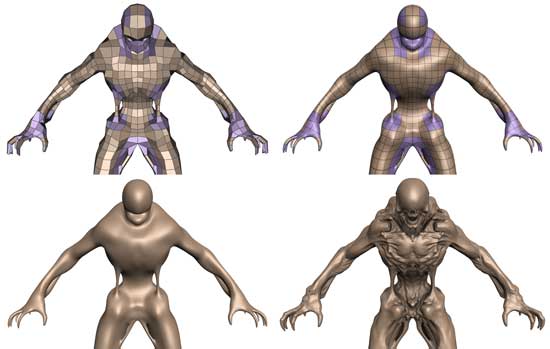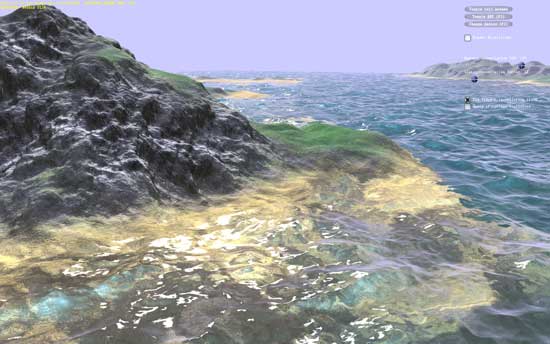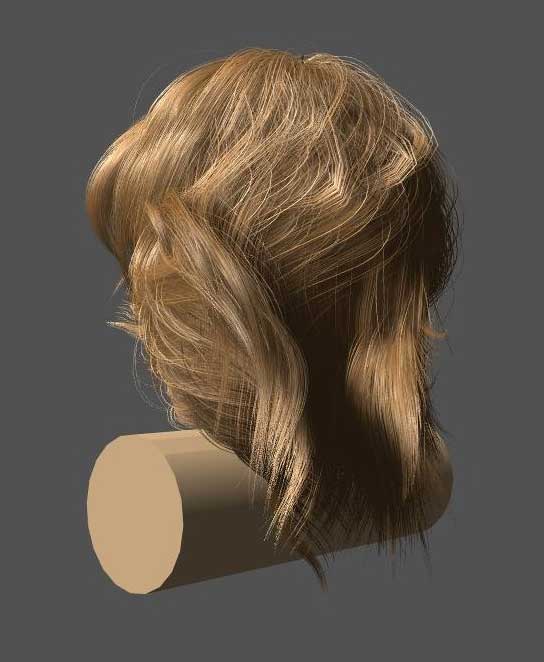Why NVIDIA Is Focused On Geometry
Up until now we haven’t talked a great deal about the performance of GF100, and to some extent we still can’t. We don’t know the final clock speeds of the shipping cards, so we don’t know exactly what the card will be like. But what we can talk about is why NVIDIA made the decisions they did: why they went for the parallel PolyMorph and Raster Engines.
The DX11 specification doesn’t leave NVIDIA with a ton of room to add new features. Without the capsbits, NVIDIA can’t put new features on their hardware and easily expose them, nor would they want to at risk of having those features (and hence die space) go unused. DX11 rigidly says what features a compliant video card should offer, and leaves you very little room to deviate.
So NVIDIA has taken a bit of a gamble. There’s no single wonder-feature in the hardware that immediately makes it stand out from AMD’s hardware – NVIDIA has post-rendering features such as 3D Vision or compute features such as PhysX, but when it comes to rendering they can only do what AMD does.
But the DX11 specification doesn’t say how quickly you have to do it.

Tessellation in action
To differentiate themselves from AMD, NVIDIA is taking the tessellator and driving it for all its worth. While AMD merely has a tessellator, NVIDIA is counting on the tessellator in their PolyMorph Engine to give them a noticeable graphical advantage over AMD.
To put things in perspective, between NV30 (GeForce FX 5800) and GT200 (GeForce GTX 280), the geometry performance of NVIDIA’s hardware only increases roughly 3x in performance. Meanwhile the shader performance of their cards increased by over 150x. Compared just to GT200, GF100 has 8x the geometry performance of GT200, and NVIDIA tells us this is something they have measured in their labs.
So why does NVIDIA want so much geometry performance? Because with tessellation, it allows them to take the same assets from the same games as AMD and generate something that will look better. With more geometry power, NVIDIA can use tessellation and displacement mapping to generate more complex characters, objects, and scenery than AMD can at the same level of performance. And this is why NVIDIA has 16 PolyMorph Engines and 4 Raster Engines, because they need a lot of hardware to generate and process that much geometry.
NVIDIA believes their strategy will work, and if geometry performance is as good as they say it is, then we can see why they feel this way. Game art is usually created at far higher levels of detail than what eventually ends up being shipped, and with tessellation there’s no reason why a tessellated and displacement mapped representation of that high quality art can’t come with the game. Developers can use tessellation to scale down to whatever the hardware can do, and in NVIDIA’s world they won’t have to scale it down very far to meet up with the GF100.
At this point tessellation is a message that’s much more for developers than it is consumers. As DX11 is required to take advantage of tessellation, only a few games exist while plenty more are on the way. NVIDIA needs to convince developers to ship their art with detailed enough displacement maps to match GF100’s capabilities, and while that isn’t too hard, it’s also not a walk in the park. To that extent they’re also extolling the other virtues of tessellation, such as the ability to do higher quality animations by only needing to animate the control points of a model, and letting tessellation take care of the rest. A lot of the success of the GF100 architecture is going to ride on how developers respond to this, so it’s going to be something worth keeping an eye on.

NVIDIA's water tessellation demo

NVIDIA's hair tessellation demo










115 Comments
View All Comments
dentatus - Monday, January 18, 2010 - link
" Im sure ATi could pull out the biggest, most expensive, hottest and fastest card in the world"- they have, its called the radeon HD5970.Really, in my Australia, the ATI DX11 hardware represents nothing close to value. The "biggest, most expensive, hottest and fastest card in the world" a.k.a HD5970 weighs in at a ridiculous AUD 1150. In the meantime the HD5850 jumped up from AUD 350 to AUD 450 on average here.
The "smaller, more affordable, better value" line I was used to associating with ATI went out the window the minute their hardware didn't have to compete with nVidia DX11 hardware.
Really, I'm not buying any new hardware until there's some viable alternatives at the top and some competition to burst ATI's pricing bubble. That's why it'd be good to see GF100 make a "G80" impression.
mcnabney - Monday, January 18, 2010 - link
You have no idea what a market economy is.If demand outstrips supply prices WILL go up. They have to.
nafhan - Monday, January 18, 2010 - link
It's mentioned in the article, but nvidia being late to market is why prices on ATI's cards are high. Based on transistor count, etc. There's plenty of room for ATI to drop prices once they have some competition.Griswold - Wednesday, January 20, 2010 - link
And thats where the article is dead wrong. For the most part, the ridiculous prices were dictated by low supply vs. high demand. Now, we finally arrived at decent supply vs. high demand and prices are dropping. The next stage may be good supply vs normal demand. That, and no second earlier, is when AMD themselves could willingly start price gouging due to no competition.However, the situation will be like this long after Thermi launched for the simple reason, that there is no reason to believe that Thermi wont have yield issues for quite some time after they have been sorted out for AMD - its the size of chipzilla that will give it a rough time for the first couple of months, regardless of its capabilities.
chizow - Monday, January 18, 2010 - link
I'm sure ATI would've if they could've instead of settling for 2nd place most of the past 3 years, but GF100 isn't just about the performance crown, its clearly setting the table for future variants based on its design changes for a broader target audience (think G92).bupkus - Monday, January 18, 2010 - link
So why does NVIDIA want so much geometry performance? Because with tessellation, it allows them to take the same assets from the same games as AMD and generate something that will look better. With more geometry power, NVIDIA can use tessellation and displacement mapping to generate more complex characters, objects, and scenery than AMD can at the same level of performance. And this is why NVIDIA has 16 PolyMorph Engines and 4 Raster Engines, because they need a lot of hardware to generate and process that much geometry.Are you saying that ATI's viability and funding resources for R&D are not supported by the majority of sales which traditionally fall into the lower priced hardware which btw requires smaller and cheaper GPUs?
Targon - Wednesday, January 20, 2010 - link
Why do people not understand that with a six month lead in the DX11 arena, AMD/ATI will be able to come out with a refresh card that could easily exceed what Fermi ends up being? Remember, AMD has been dealing with the TSMC issues for longer, and by the time Fermi comes out, the production problems SHOULD be done. Now, how long do you think it will take to work the kinks out of Fermi? How about product availability(something AMD has been dealing with for the past few months). Just because a product is released does NOT mean you will be able to find it for sale.The refresh from AMD could also mean that in addition to a faster part, it will also be cheaper. So while the 5870 is selling for $400 today, it may be down to $300 by the time Fermi is finally available for sale, with the refresh part(same performance as Fermi) available for $400. Hmmm, same performance for $100 less, and with no games available to take advantage of any improved image quality of Fermi, you see a better deal with the AMD part. We also don't know what the performance will be from the refresh from AMD, so a lot of this needs to take a wait and see approach.
We have also seen that Fermi is CLEARLY not even available for some leaked information on the performance, which implies that it may be six MORE months before the card is really ready. Showing a demo isn't the same as letting reviewers tinker with the part themselves. Really, if it will be available for purchase in March, then shouldn't it be ready NOW, since it will take weeks to go from ready to shipping(packaging and such)?
AMD is winning this round, and they will be in the position where developers will have been using their cards for development since NVIDIA clearly can't. AMD will also be able to make SURE that their cards are the dominant DX11 cards as a result.
Targon - Wednesday, January 20, 2010 - link
Why do people not understand that with a six month lead in the DX11 arena, AMD/ATI will be able to come out with a refresh card that could easily exceed what Fermi ends up being? Remember, AMD has been dealing with the TSMC issues for longer, and by the time Fermi comes out, the production problems SHOULD be done. Now, how long do you think it will take to work the kinks out of Fermi? How about product availability(something AMD has been dealing with for the past few months). Just because a product is released does NOT mean you will be able to find it for sale.The refresh from AMD could also mean that in addition to a faster part, it will also be cheaper. So while the 5870 is selling for $400 today, it may be down to $300 by the time Fermi is finally available for sale, with the refresh part(same performance as Fermi) available for $400. Hmmm, same performance for $100 less, and with no games available to take advantage of any improved image quality of Fermi, you see a better deal with the AMD part. We also don't know what the performance will be from the refresh from AMD, so a lot of this needs to take a wait and see approach.
We have also seen that Fermi is CLEARLY not even available for some leaked information on the performance, which implies that it may be six MORE months before the card is really ready. Showing a demo isn't the same as letting reviewers tinker with the part themselves. Really, if it will be available for purchase in March, then shouldn't it be ready NOW, since it will take weeks to go from ready to shipping(packaging and such)?
AMD is winning this round, and they will be in the position where developers will have been using their cards for development since NVIDIA clearly can't. AMD will also be able to make SURE that their cards are the dominant DX11 cards as a result.
chizow - Monday, January 18, 2010 - link
@bupkus, no, but I can see a monster strawman coming from a mile away.Calin - Monday, January 18, 2010 - link
"Because with tessellation, it allows them to take the same assets from the same games as AMD and generate something that will look better"No it won't.
If the game will ship with the "high resolution" displacement mappings, NVidia could make use of them (and AMD might not, because of the geometry power involved). If the game won't ship with the "high resolution" displacement maps to use for tesselation, then NVidia will only have a lot of geometry power going to waste, and the same graphical quality as AMD is having.
Remember that in big graphic game engines, there are multiple "video paths" for multiple GPU's - DirectX 8, DirectX 9, DirectX 10, and NVidia and AMD both have optimised execution paths.